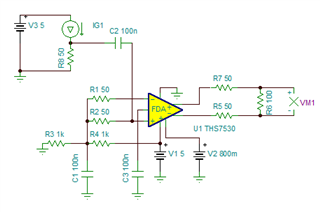Other Parts Discussed in Thread: THS7530, THS4541
We're using the THS7530 VGA chip on one of our new projects, and we're having a noise problem. According to the specification of THS7530, the noise of the chip is 1.1nV/√Hz. In contrast, the noise of the high-speed operational amplifier THS4541 is 2.2nV/√Hz. I try to use TINA simulation software to build a simulation circuit for the noise test of the two chips. The test results show that the total noise output of THS7530 and THS4541 at 200MHz is about 200uV and 70uV respectively. The simulation circuit and data are shown in the figure below.


However, after the actual production of these two circuits, we used oscilloscope to test the noise of these two circuits, and the noise of THS7530 is about 2.6mV (RMS), which is more than 10 times larger than the simulation data, while the noise of THS4541 is 0.13mV, which is similar to the simulation data. We have made a total of 5 test boards of THS7530, and the noise results are all 2.6mV, which can exclude the possibility of single chip abnormality. In addition, we also purchased the demo board of THS7530 by TI, and the noise tested was also about 2.6mV.
Your help and assistance are urgently needed.
thank you






